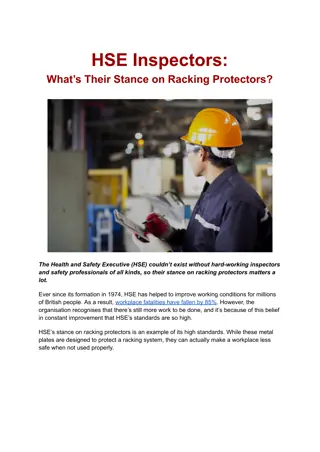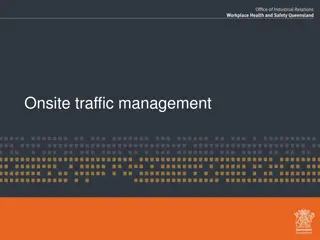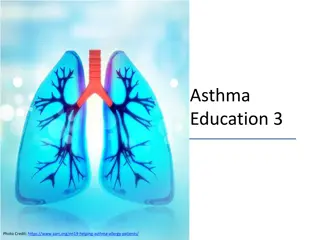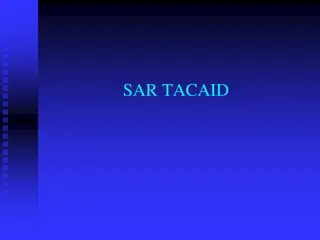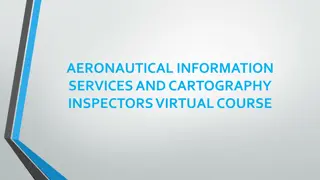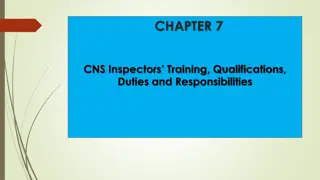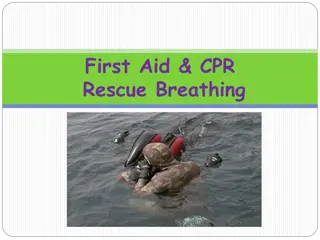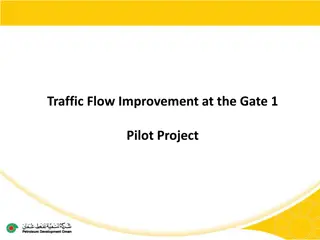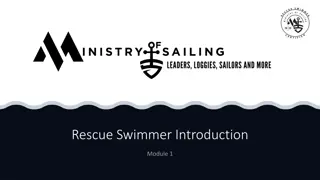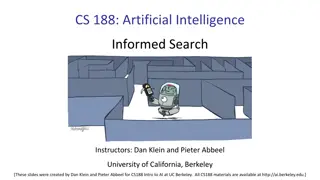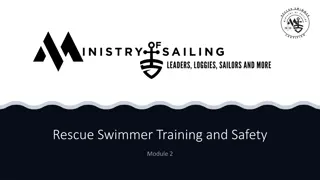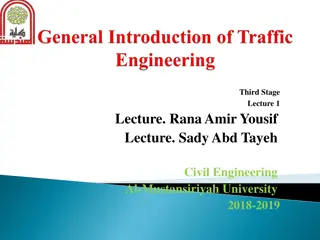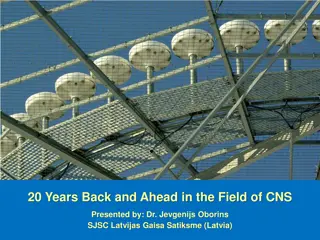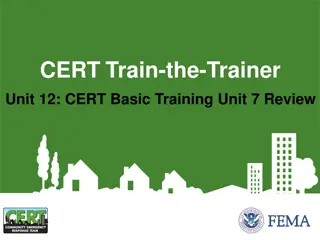Air Traffic Management & Search and Rescue Inspectors Virtual Course Overview
This virtual course provides insights into the roles of Air Traffic Services oversight organizations and Air Traffic and Search & Rescue Safety Inspectors. It covers topics such as safety oversight responsibilities, licensing processes, safety management systems, and auditing practices. Participants will gain knowledge and skills to enhance safety within the aviation sector.
Download Presentation

Please find below an Image/Link to download the presentation.
The content on the website is provided AS IS for your information and personal use only. It may not be sold, licensed, or shared on other websites without obtaining consent from the author. Download presentation by click this link. If you encounter any issues during the download, it is possible that the publisher has removed the file from their server.
E N D
Presentation Transcript
Air Traffic Management & Search and Rescue Inspectors Virtual Course 1
The role of an Air Traffic Services (ATS) oversight organization and an Air Traffic and Search & Rescue Safety Inspector: 2 Continuously improve the safety of the Air Navigation Service Provider (ANSP) particularly the ATM and ASAR functions and the State airspace system through regulatory oversight.
Course Content 3 State safety oversight responsibilities The functions of an Air Traffic Services (ATS) and/or Aeronautical Search and Rescue oversight organization Safety Management Systems Licensing and approvals processes Safety performance monitoring; and Auditing Air Traffic Service Providers
Course Objectives 4 At the end of this course the participant should be able to: Describe the functions of an ATM/SAR oversight organization; State the duties and responsibilities an ATM/SAR inspector; Highlight an ATM/SAR inspector s role within the ATM oversight organization; Demonstrate an understanding of State safety management responsibilities; List requirements for licensing ATM personnel; Develop safety oversight tools for oversight of ATM & SAR providers; Describe reviews and approvals of proposed changes to the airspace system; Perform an audit of an ATS & SAR service provider; Write and disseminate an audit report; and Develop technical guidance material.
Chapter One Chapter One An Overview of Safety oversight and the Universal Safety Audit Programme - Continuous Monitoring Approach (USOAP-CMA) 5
Definitions 6 Aviation safety oversight - The process of ensuring that aviation professionals such as air traffic controllers, Search and rescue coordinators and administrators perform their functions safely and responsibly and in compliance with applicable regulations, procedures, rules, doctrines etc. Inspectorate - An office or entity designated by the regulatory body to support safety oversight activities over the service providers . An inspectorate may be composed of inspectors, technical support staff, administrative personnel and others directly engaged in supporting the office or entity s oversight activities. Inspectors - Personnel directly engaged in carrying out oversight activities (e.g. inspections, audits, etc.) over the service providers. Safety - The state in which the possibility of harm to persons or of property damage is reduced to, and maintained at or below, an acceptable level through a continuing process of hazard identification and safety risk management.
Definitions 7 Safety Management Systems (SMS) - A systematic approach to managing safety, including the necessary organizational structures, accountabilities, policies and procedures. Safety oversight - a function performed by the State to ensure that individuals and organizations performing an aviation activity comply with safety-related national laws, regulations and procedures. State - refers to the authority that is signatory to the Chicago Convention and which normally establishes a Civil Aviation Authority (CAA) and other aviation- related authorities. Surveillance - Processes through which the State proactively verifies through inspections, audits and other activities that aviation licence, certificate, authorization or approval holders continue to meet established requirements and function at the level of competency and safety required by the State.
Definitions 8 Validation - The process of proving that the functions, procedures, controls, and safety standards are correct and the right system is being built (i.e., the requirements are unambiguous, correct, complete, and verifiable). Verification - The process that ensures that the system requirements have been met by the design solution and the system is ready to be used in the operational environment for which it is intended.
The ICAO convention 9 Safety oversight has its roots in the ICAO convention (The Chicago convention) of 1944. The Purpose of the Convention The convention agreed on certain principles and arrangements in order that international civil aviation may be developed in a safe and orderly manner and that international air transport services may be established on the basis of equality of opportunity and operated soundly and economically.
Aims and objectives of ICAO stated in article 44 of the Chicago convention 10 To develop the principles and techniques of international air navigation to foster the planning and development of international transport so as to: 1) Insure the safe and orderly growth of international civil aviation throughout the world; 2) Encourage the arts of aircraft design and operation for peaceful purposes; 3) Encourage the development of airways, airports, and air navigation facilities for international civil aviation; 4) Meet the needs of the peoples of the world for safe, regular, efficient and economical air transport; 5) Prevent economic waste caused by unreasonable competition; 6) Insure that the rights of contracting States are fully respected and that every contracting State has a fair opportunity to operate international airlines; 7) Avoid discrimination between contracting States; 8) Promote safety of flight in international air navigation; 9) Promote generally the development of all aspects of international civil aeronautics.
ICAOs Strategic Objectives Relevant to ANS Provision and Oversight 11 1. Safety: Enhance global civil aviation safety - focused primarily on the State's regulatory oversight capabilities. 2. Air Navigation Capacity and Efficiency: Increase the capacity and improve the efficiency of the global civil aviation system - focused primarily on upgrading the air navigation and aerodrome infrastructure and developing new procedures to optimize aviation system performance.
Articles of the Convention 12 The Convention has 96 articles Establishes privileges and restrictions Provides for adoption of Standards and Recommended Practices Accepts principle of sovereignty of the airspace above a State s territory Privileges unrestrictive passage of aircraft between States or over their territory from a technical point of view recognition of Licenses and Certificates bring obligations to abide by Standards and Recommended Practices contained in Annexes
Articles relevant to the Air Traffic Services and Search & Rescue 13 Article 3: Civil and state aircraft This Convention shall be applicable only to civil aircraft, and shall not be applicable to state aircraft. Aircraft used in military, customs and police services shall be deemed to be state aircraft. No state aircraft of a contracting State shall fly over the territory of another State or land thereon without authorization by special agreement or otherwise, and in accordance with the terms thereof.
Articles relevant to the Air Traffic Services and Search & Rescue 14 Article 3 bis: Interception of Civil Aircraft a) States must refrain from resorting to the use of weapons against civil aircraft in flight and that, in case of interception, the lives of persons on board and the safety of aircraft must not be endangered. b) Every State, in the exercise of its sovereignty, is entitled to require the landing at some designated airport of a civil aircraft flying above its territory without authority or if there are reasonable grounds to conclude that it is being used for any purpose inconsistent with the aims of this Convention; it may also give such aircraft any other instructions to put an end to such violations. c) Every civil aircraft shall comply with an order given in conformity with paragraph b) above, and in which case each contracting State shall establish all necessary provisions in its national laws or regulations to make such compliance mandatory for any civil aircraft registered in that State or operated by an operator who has his principal place of business or permanent residence in that State.
Articles relevant to the Air Traffic Services and Search & Rescue 15 Article 12: Rules of the air Each contracting State undertakes to adopt measures to insure that every aircraft flying over or maneuvering within its territory and that every aircraft carrying its nationality mark, wherever such aircraft may be, shall comply with the rules and regulations relating to the flight and maneuver of aircraft there in force.
Article 25: Aircraft in distress 16 Each contracting State undertakes to provide such measures of assistance to aircraft in distress in its territory as it may find practicable, and to permit, subject to control by its own authorities, the owners of the aircraft or authorities of the State in which the aircraft is registered to provide such measures of assistance as may be necessitated by the circumstances. Each contracting State, when undertaking search for missing aircraft, will collaborate in coordinated measures which may be recommended from time to time pursuant to this Convention.
Article 28; Air navigation facilities and standard systems 17 Each contracting State undertakes, so far as it may find practicable, to: a) Provide, in its territory, airports, radio services, meteorological services and other air navigation facilities to facilitate international air navigation, in accordance with the standards and practices recommended or established from time to time, pursuant to this Convention; b) Adopt and put into operation the appropriate standard systems of communications procedure, codes, markings, signals, lighting and other operational practices and rules which may be recommended or established from time to time, pursuant to this Convention; c) Collaborate in international measures to secure the publication of aeronautical maps and charts in accordance with standards which may be recommended or established from time to time, pursuant to this Convention.
Article 37: Adoption of international standards and procedures 18 Each contracting State undertakes to collaborate in securing the highest practicable degree of uniformity in regulations, standards, procedures, and organization in relation to aircraft, personnel, airways and auxiliary services in all matters in services which such uniformity will facilitate and improve air navigation. To ensure currency, International Civil Aviation Organization (ICAO) shall adopt and amend from time to time, international standards and recommended practices and procedures dealing with Air Traffic Services and Search & Rescue among others.
Article 38: Departures from international standards and procedures 19 When a State finds it impracticable to comply with the Standards in full, the State shall give immediate notification to the International Civil Aviation Organization of the differences between its own practice and that established by the international standard.
Overview of ICAO and the Universal Safety Audit Programme (USOAP) 20 Air Traffic Services & Search and rescue form separate audit areas within the Air Navigation Services audit area under the Universal Safety Oversight Continuous Monitoring Approach (USOAP-CMA) framework. The annexes to the convention that fall under this subset are: Annex 2 Rules of the air, Annex 11 Air traffic services, and Annex 12 Aeronautical search and rescue
ATS Oversight and The USOAP-CMA 21 Early State safety audits were based on implementation of standards in three annexes only; Annexes 1, 6 and 8 At the 33rd Assembly, USOAP was expanded to include Annexes 11 (Air Traffic Services), 13 and 14 At the 35th Assembly, USOAP was further expanded to include all safety related annexes,
ATS and SAR Within The Continuous Monitoring Approach 22 ATS & SAR are essential air navigation services that enable safety and efficiency of air transport. These services therefore benefit from CMA framework that enables Collection and analysis of safety information from Member States and other stakeholders in order to identify and prioritize appropriate oversight and monitoring activities to be carried out by ICAO. CMA is a strategy that uses a risk-based approach for measuring and monitoring the safety oversight capabilities and improving safety performance of States and global aviation on a continuous basis..
Continuous monitoring approach (CMA) 23 CMA enables validation of; Effective implementation of corrective action plans (CAPs) submitted by States including subsequent progress reports received following audits. The status of corrective or mitigating measures taken by State to correct deficiencies including safety concerns identified during an audit with regard to the State s safety oversight capability.
USOAP CMA PRINCIPLES 24 Sovereignty. Every Member State has complete and exclusive sovereignty over the airspace of its territory. Accordingly, ICAO fully respects a sovereign State s responsibility and authority for safety oversight, including its decision-making powers with respect to implementing corrective actions related to identified deficiencies
USOAP CMA PRINCIPLES 25 Universality. All Member States shall be subject to continuous monitoring activities by ICAO, in accordance with the principles, methodologies, processes and procedures established for conducting such activities, and on the basis of the Memorandum of Understanding (MOU) signed by ICAO and each Member State
USOAP CMA PRINCIPLES 26 Transparency and disclosure. USOAP CMA activities shall be conducted under a process that is fully transparent and open for examination by all parties concerned. There shall be full disclosure of the finalized results of USOAP CMA activities which shall provide sufficient information for Member States to make informed decisions regarding the safety oversight capability of other Member States.
USOAP CMA PRINCIPLES 27 Timeliness. Results of USOAP CMA activities shall be produced and posted by ICAO in a timely manner, in accordance with a predetermined schedule for the preparation and submission of these results. Member States shall submit updates, comments, action plans and all required documentation in accordance with the timelines set out in the USOAP CMA on-site activity timelines and in the MOU. Relevant information will be published by ICAO on an ongoing basis.
USOAP CMA PRINCIPLES 28 All-inclusiveness. The scope of USOAP CMA includes the ICAO SARPs contained in all safety-related Annexes to the Convention, Procedures for Air Navigation Services (PANS), guidance material and related procedures. and practices
USOAP CMA PRINCIPLES 29 Systematic, consistent and objective. USOAP CMA shall be conducted in a systematic, consistent and objective manner. Standardization and uniformity in the scope, depth and quality of USOAP CMA activities shall be achieved through the use of trained and qualified auditors and SMEs, through the use of standardized PQs and the provision of relevant guidance material
USOAP CMA PRINCIPLES 30 Fairness. USOAP CMA activities shall be conducted in a manner such that Member States have every opportunity to monitor, comment on, and respond to the CMA processes.
USOAP CMA PRINCIPLES 31 Quality. The quality of USOAP CMA activities shall be ensured by assigning trained and qualified auditors and SMEs to conduct USOAP CMA activities, as well as by implementing and maintaining a documented QMS that continually monitors and evaluates feedback received from USOAP CMA stakeholders to ensure their ongoing satisfaction.
Critical Elements of a Safety Oversight System 32 Critical elements (CEs) are essentially the safety defense tools of a State s safety oversight system required for the effective implementation of safety- related standards, policy and associated procedures. There are 8 Critical Elements that ICAO considers essential for a State to Establish, Implement and Maintain so as to have an effective safety oversight system The CEs are divided into two categories; CE 1-5 (Establishment CEs) and CE 6-8 (Implementation CEs)
Critical elements of a safety oversight system 33 Critical Elements of a Safety Oversight System
Critical elements of a safety oversight system 34 Understanding the framework described by the Critical Elements will help the ATM/SAR inspectors to understand their responsibilities as ATM/SAR inspectors, organization s responsibilities, and ANSP responsibilities While all of the Critical Elements are important to effective aviation safety oversight, CEs 4, 6, 7 and 8 (to a great extent but not entirely) are most closely associated with the ATS & SAR inspector responsibilities
CE 4: Technical Personnel Qualification and Training 35 Civil Aviation Authorities are required to: Establish minimum knowledge and experience requirements for the technical personnel performing safety oversight functions including ATS & SAR inspectors. Provide appropriate training to maintain and enhance their competence at the desired level. Such training should include initial and recurrent (periodic) training.
CE 4: Technical Personnel Qualification and Training 36 The ATS & SAR oversight organization must ensure that: The ATS & SAR Inspectors are capable of conducting effective surveillance of air traffic services in a standardized manner. Technical personnel performing ATS & SAR safety oversight functions are expected to be at least as qualified as the ANSP personnel to be inspected or supervised to ensure they can adequately assess ANSP s performance. Training and qualifications for ATS & SAR insopectors form the basis on which to license the inspectorate staff.
CE 4: Technical Personnel Qualification and Training 37 Desirable Qualities of an ATM/SAR inspector Have a high degree of integrity; Be impartial in carrying out your tasks; Be tactful; Possess good communication skills; Have a good understanding of human nature; Understand data collection; and Be methodical and possess analytical skills.
CE 4: Technical Personnel Qualification and Training 38 ATM/SAR inspectors must therefore have the skills and knowledge, or competencies, to effectively perform oversight of ATS & SAR providers. Competencies are the integrated knowledge, skills, judgment, and attributes that people need to perform a job effectively
CE 6: Licensing, Certification, Authorization and Approval Obligations 39 Air traffic controllers must meet age, knowledge, experience, medical fitness, and skill requirements. ANSPs must meet operational and safety requirements to provide air navigation services in the airspace system. Therefore, Critical Element 6 calls for the implementation of processes and procedures to ensure that personnel and organizations performing safety critical aviation activities meet the established requirements before they are allowed to exercise the provisions or authorizations of a license, certificate, authorization, and/or approval to conduct the relevant aviation activity.
CE 7: Surveillance Obligations 40 A State s obligation for a safe and orderly civil aviation system does not end with the issuance of licenses, ratings, certificates, or other approvals. Critical Element 7 calls for the establishment of processes, such as inspections and audits, to proactively ensure that: aviation license, certificate, authorization, and/or approval holders continue to meet the established requirements and; function at the level of competency and safety required by the State to undertake an aviation-related activity for which they have been licensed, certified, authorized, and/or approved to perform.
CE 7: Surveillance Obligations 41 Annex 19 to the Convention on International Civil Aviation requires the State to implement documented surveillance processes by: defining and planning inspections, audits, and; monitoring activities on a continuous basis, to proactively assure that aviation license, certificate, authorization, and/or approval holders continue to meet the established requirements.
CE 7: Surveillance Obligations 42 Surveillance should be accomplished on a continuing basis, performed at specified times or intervals, or conducted in conjunction with the renewal of a license, certificate, or other approval. The standards of an organization s capability and competence should at all times be equal to or exceed those required at the time of original certification (the baseline). Accordingly, ATS providers must convincingly demonstrate that operations are being conducted in accordance with requirements.
CE 7: Surveillance Obligations 43 Surveillance is a primary ATS/SAR inspector s responsibility. Through performing audits, inspections and continuous monitoring, an ATM/SAR inspector ensures the ANSP proactively addresses non-conformances before they become safety hazards and risks leading to accidents. Surveillance of ATS & SAR operations and personnel is used to verify compliance with regulations, procedures, plans, and policies and is critical to an ATM/SAR provider s effectiveness.
End of Chapter 1 End of Chapter 1 44







